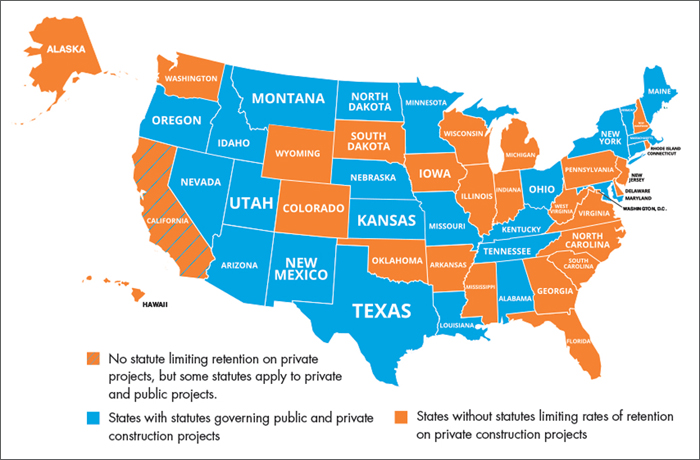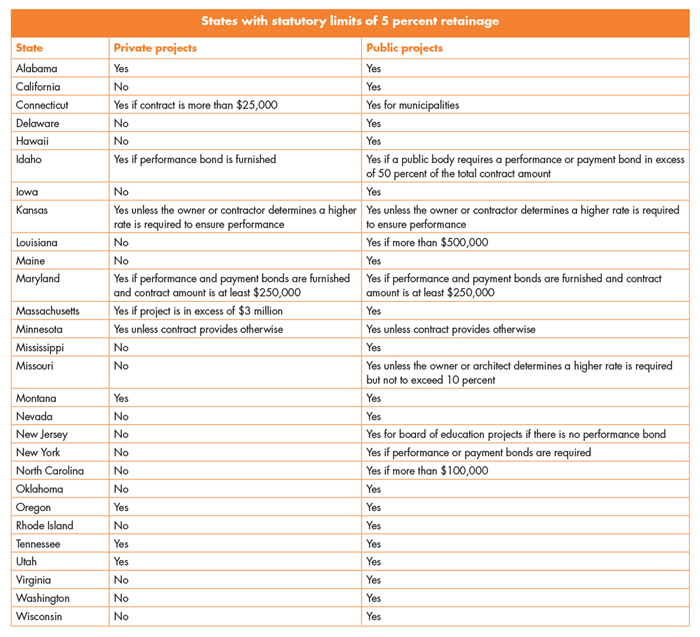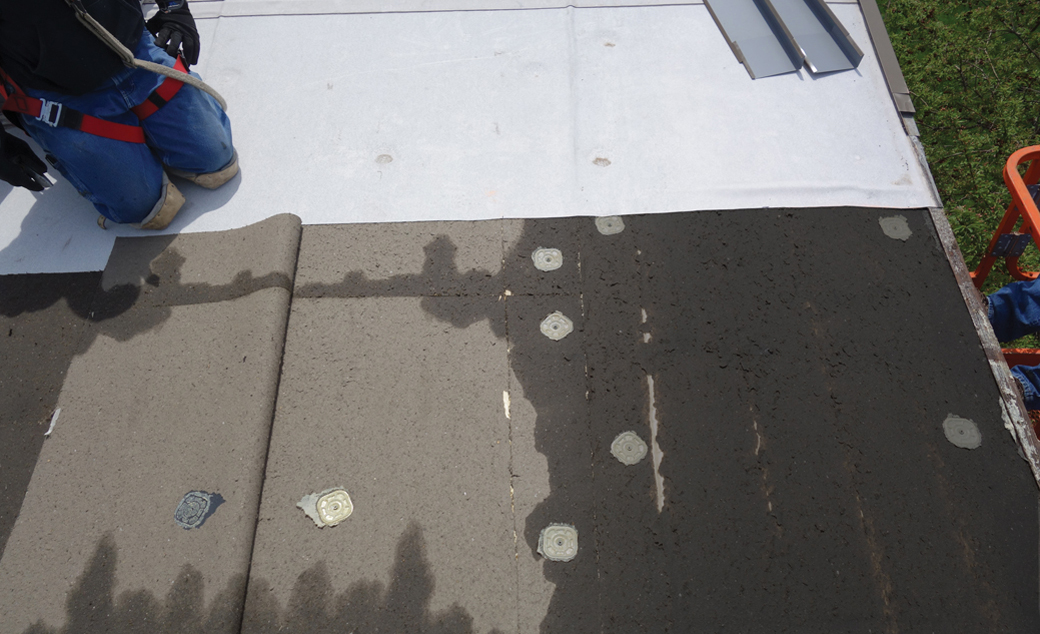Often prompted by lobbying efforts by the American Subcontractors Association, state legislatures have enacted an array of statutes governing retainage on construction projects. These statutes generally seek to limit the rate of retainage, particularly on large projects, to 5 percent of the contract amount and expedite the release of retainage when there is no problem justifying withholding it.
Three statutes
Massachusetts is the most recent state to enact legislation limiting retainage to 5 percent. Following negotiations between the Associated Subcontractors of Massachusetts and Associated General Contractors of Massachusetts,
Massachusetts enacted a statute in August 2014 applicable to private construction contracts entered into on or after Nov. 6, 2014. The new law limits the rate of retainage on private construction projects to 5 percent of each progress payment. The 2014 statute is the first legislation in Massachusetts governing retainage on private construction projects but applies only to projects with a prime contract value of $3 million or more and where a lien could be established. The statute applies to subcontracts as long as the prime contract with the owner is $3 million or more.
The Massachusetts statute prohibits withholding more than 5 percent retainage on any progress payment. Contract terms that provide for a blended overall 5 percent retainage rate with 10 percent retainage being withheld during the first half of a job and no further retainage being held thereafter do not satisfy the new law. The statutory requirements cannot be waived by contract, and contracting parties may not agree to a different amount of retainage. The law states any purported waiver of limitation shall be void and unenforceable. Prime contractors are required to pay retainage to subcontractors within seven days of receipt from the owner. The law does not apply to residential construction projects of four or fewer dwelling units.

Nebraska also enacted legislation in 2014 governing retainage on construction projects. As of July 18, 2014, an owner, contractor or subcontractor in Nebraska may not withhold more than 10 percent retainage. When work is 50 percent complete and the contractor has performed satisfactorily, no more than 5 percent retainage can be held from progress payments as long as the contractor or subcontractor has provided "satisfactory and reasonable assurances" of continued performance and financial responsibility to complete the work.
Owners must release retainage no more than 45 days after the project or a designed portion of the project is substantially complete. Contractors are to pay retainage to subcontractors within 10 days of receiving retainage from the owner if the subcontractor has performed its work and all conditions in the contract have been satisfied. Before the 2014 legislation, there was no statutory limitation on retainage in Nebraska.
Maryland enacted legislation in 2013, sponsored by the American Subcontractors Association of Baltimore, prohibiting local governments, contractors and subcontractors from withholding more than 5 percent on Maryland public construction projects as of July 1, 2013, if the contractor has furnished 100 percent performance and payment bonds. Before passage of the 2013 legislation, local government units established by the state were permitted to withhold up to 10 percent retainage during the first half of the contract and 5 percent thereafter.
The 2013 Maryland statute built upon legislation that took effect Oct. 1, 2008, limiting the rate of retainage to no more than 5 percent on private construction projects. Maryland had limited retainage on public projects to 5 percent since 2003. However, the 5 percent limitation on private construction projects enacted in 2008 applies only to contracts where the general contractor or subcontractor provides performance and payment bonds in the full amount of their respective contracts and the contract amount is at least $250,000. The retainage percentage withheld from subcontractors cannot exceed the rate withheld from the prime contractor by the owner. As is often the case, the statute does not apply to single-family residences.
Tennessee statutes
Tennessee has enacted several statutes during the past decade governing retainage on public and private construction projects, making Tennessee one of the most highly regulated states pertaining to retainage. For many years, Tennessee limited retainage to 10 percent and required retainage for contracts and subcontracts in excess of $500,000 be placed in escrow accounts, but escrow accounts were not required to earn interest.
Effective July 1, 2007, Tennessee reduced the maximum rate of retainage an owner could hold on public and private construction projects to 5 percent but still limited the escrow requirement to construction contracts in excess of $500,000. Tennessee law requires prime contractors to release retainage to subcontractors and suppliers within 10 days of their receipt of retainage from the owner on public and private jobs, and subcontractors are similarly required to pay retainage to sub-subcontractors and suppliers within 10 days of their receipt of retainage from the prime contractor. The Tennessee statute does not apply to residential construction.
In 2008, the Tennessee legislature added provisions requiring retainage on projects where the prime contract was greater than $500,000 be deposited in an interest-bearing escrow account held by a third party and prohibiting waiver of the retainage requirements in a construction contract.
In addition, the Tennessee legislation went further than any other state by categorizing a violation of the retainage statute as a Class A criminal misdemeanor subject to a $3,000 per day fine and a $300 per day payment to the contractor for each day retainage was not escrowed. To avoid the $3,000 per day penalty on contracts more than $500,000, owners must limit retainage to 5 percent of the contract amount, deposit the retained funds in a separate interest-bearing account with a third party and pay the retainage to the prime contractor within 90 days of substantial work completion. The same requirements and penalties apply to prime contractors who must release retainage to subcontractors and suppliers within 10 days of the retainage payment from the owner.
The Tennessee legislature revisited the retainage statute in 2012 and added more requirements and penalties though the escrow requirement still applies only to contracts in excess of $500,000. As of July 1, 2012, the interest-bearing escrow account with a third party must be established upon the withholding of any retainage and owners who withhold retainage must provide written notice to the prime contractor each time retainage is withheld, identifying the financial institution holding the escrowed funds, the account number and the amount of retained funds deposited in the account. The 2012 legislation also added yet another penalty for noncompliance, providing that a party violating the retainage requirements would be subject to court-ordered restitution.
Other examples
Oregon enacted legislation in 2013 limiting retainage a contractor may withhold from a subcontractor at 5 percent for all contracts entered into after Jan. 1, 2014, regardless of whether a payment bond has been furnished.
Based on legislation enacted in October 2011, California now caps retainage at 5 percent on public projects and requires payment to subcontractors be made within seven days after the upstream contractor receives payment. The California statute applies to contracts with the state agencies and departments, the University of California, cities, counties, public authorities, political subdivisions and special districts entered into between Jan. 1, 2012, and Jan. 1, 2016, unless the project is determined to be "substantially complex" and a different retention rate is stated in the bid documents.

States with statutory limits of 5 percent retainage
Louisiana enacted a statute in 2012 requiring owners to deposit retainage in interest-bearing escrow accounts. The statute applies to all private construction contracts of $50,000 or more. The escrow account must be maintained at a qualified financial institution jointly selected by the owner and contractor. The statute does not address whether the interest-bearing escrow account requirement could be waived by contract and does not include an enforcement mechanism. The new law does not apply to single- and double-family residences.
Alabama's current law governing retainage on private construction projects went into effect Sept. 1, 2011. It effectively limits retainage to 5 percent of the estimated amount of work properly done and the value of insured, stored materials because the maximum retainage rate is 10 percent and no additional retainage may be withheld after the job is 50 percent complete.
For the first half of a job, the owner and prime contractor may withhold 10 percent of each pay application. Those funds can be withheld until the job is completed, but no more retainage can be collected. If a party withholds more retainage than the law allows, the improperly withheld retainage accrues interest at a rate of 1 percent per month. A contractor is not permitted to withhold a higher rate of retainage from subcontractors than is retained by the owner. The same provision applies to subcontractors in their dealings with sub-subcontractors. The statute does not apply to contracts with the state, contracts less than $10,000 and homebuilder projects. For public projects in Alabama, the effective rate of retainage during the course of construction is limited to 2.5 percent. Five percent retainage can be withheld for the first half of a project, and no further retention can be held thereafter.
Connecticut enacted legislation in 2010 reducing the maximum retainage rate from 7.5 percent to 5 percent applicable to private construction contracts entered into on or after Oct. 1, 2010. The 5 percent limitation applies to contracts more than $25,000 entered into by owners, contractors and subcontractors and does not apply to residential properties containing four or fewer units. Although retainage on public contracts with Connecticut state agencies other than the Department of Transportation is allowed up to 10 percent, Connecticut municipalities can withhold no more than 5 percent.
Kansas also enacted legislation in 2010 limiting retainage to 5 percent on public and private construction contracts with two exceptions. The rate of retainage can be increased up to 10 percent if the owner and architect or general contractor determine a higher rate of retainage is required to ensure performance or, if during the course of construction, the owner and architect find the general contractor or subcontractor is not meeting contract terms or performing according to schedule or there is a problem with workmanship.
All told, every state except West Virginia has a statute pertaining to retainage.
New Mexico has taken the boldest step, prohibiting retainage as of 2007 on most private and public construction projects other than road contracts, which are limited to 5 percent retainage. North Carolina does not hold any retainage on public projects less than $100,000. In New Jersey, retainage on public projects, including municipalities and counties, generally is limited to 2 percent and, upon substantial completion, is reduced to 1 percent. For projects with local boards of education in New Jersey, retainage is limited to 2 percent if there is a performance bond and the outstanding contract balance exceeds $500,000; retainage is limited to 5 percent if there is no performance bond or the outstanding contract balance is less than $500,000.
Historically, many states were reluctant to enact laws regulating retainage on private construction projects, believing the terms of private construction contracts should be left to negotiation by the contracting parties. The surety industry has long advocated a "hands-off" approach by state legislatures. But largely because of the efforts of the American Subcontractors Association, many states have passed laws addressing retainage in private construction contacts.
Release of retainage
Several states require owners release retainage to contractors and that prime contractors release retainage to subcontractors within a certain time period. For example, in California, as a result of the 2011 legislation, contractors on private and public projects must pay subcontractors within seven days of receipt of retention from the owner. Failure to pay retention carries a penalty of 2 percent per month and attorneys' fees may be awarded. This provision cannot be waived in a contract.
In Maine, contractors are required to pay subcontractors and suppliers the full amount within seven days after receipt of retainage. For public projects in South Carolina, contractors are required to pay retainage to subcontractors within 10 days of receipt from the state agency. Prime contractors in Tennessee are required to release retainage to subcontractors and suppliers within 10 days of payment of retainage from the owner on public and private jobs.
In several states, including Alabama, Maryland and Montana, and particularly with regard to public construction projects, contractors and subcontractors are not to withhold a greater rate of retainage from subcontractors and sub-subcontractors than is withheld by the owner unless there is reasonable justification for withholding a greater amount.
Interest on retainage
Louisiana, Michigan, Ohio, South Carolina and Tennessee are among the states requiring interest be paid on retainage. For public projects in Michigan and Ohio, retainage is to be placed in an interest-bearing account and paid to the contractor as part of final payment. In Michigan, if there is a delay in project completion that is the fault of the contractor, the interest earned becomes the property of the state agency issuing the contract. South Carolina and Tennessee require retainage on public and private construction projects to be deposited in an interest-bearing escrow account.
Know the law
You should be familiar with statutes governing retainage in the states where you work to ensure you receive retainage in accordance with the law of that state and that you comply with the law when dealing with subcontractors and sub-subcontractors. Statutes governing retainage are a function of state law and vary among states. The statutes have changed substantially and are periodically revised in response to efforts by construction trade associations at the state legislature level.
Although most construction contracts still routinely call for 10 percent retainage, many states now limit retainage to 5 percent and the trend is to expand the reach of retainage statutes to private construction contracts and ameliorate the adverse impact of retainage on contractors whose payments are withheld. Knowing the law and requiring the parties with whom you contract to comply may improve your cash flow and help you avoid liability.
Stephen M. Phillips is a partner with Atlanta-based law firm Hendrick, Phillips, Salzman & Flatt.
States with higher retainage
Several states have retainage set at 10 percent for public projects but with differing approaches as follows: Arizona, Arkansas, Colorado (for contracts exceeding $150,000), Connecticut (for state agencies other than the Department of Transportation), the District of Columbia, Florida, Georgia, Louisiana (for projects less than $500,000), New York (if there is no performance or labor and material payment bond), Pennsylvania (exclusive of contracts with the Department of General Services) and Wyoming. After 50 percent of the work is completed satisfactorily, no more retainage is to be withheld on public projects in Arkansas and Colorado. In Arizona, when 50 percent of the work is complete and satisfactory, the state agency is to release half the retainage.
Kansas, Kentucky, Missouri, Nebraska and North Dakota limit retainage to 10 percent for public and private construction contracts. Nevada limits retainage to 5 percent on public projects and 10 percent on private projects. South Carolina limits retainage to 3.5 percent on public projects.
In Indiana, the state can retain 6 percent on contracts in excess of $1 million until the work is 50 percent complete or may hold 3 percent until the work is substantially complete. Local governments and school districts in Indiana can withhold between 6 and 10 percent of the value of the work on contracts more than $200,000 until the project is 50 percent complete and no additional retainage thereafter, or they can withhold a maximum of 5 percent but not less than 3 percent of the value of the work for a project's duration.
In Ohio, the statutory retainage limit on public projects is 8 percent of the labor estimate prepared by the contractor and approved by the architect or engineer.
Alaska, Illinois, New Hampshire and Vermont have not set a maximum retainage rate.



